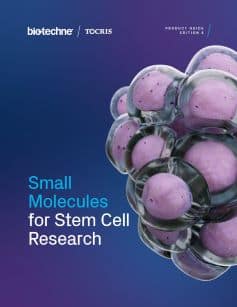Stem Cell Therapy
Stem cells are unspecialized cells that can be induced to differentiate into a more specific cell type and are able to renew by mitosis. Their ability to differentiate into any cell type is the basis of regenerative medicine, where stem cells or cells derived from them are introduced into the body to replace cells that have died, or to support dying cells. Stem cell therapy has the potential to treat a wide range of disorders including cancer, neurodegenerative diseases, bone and muscle trauma, heart disease and type I diabetes.
Stem Cell Therapy Product Areas
Small molecules can be used at all stages of the stem cell workflow: to induce reprogramming or enhance its efficiency; to promote self-renewal of stem cells; to enhance pluripotency of induced stem cells; to suppress spontaneous differentiation; to drive differentiation into a specific specialized cell type; and to grow and maintain organoid cultures.
Stem cells used in therapy can be directly isolated from the donor. The most widely used stem cell therapy of this type is a bone marrow transplant, where hematopoietic stem cells (HSCs) derived from bone marrow or peripheral blood are given to a patient to treat cancers of the blood or bone marrow. HSCs may come from the patient (autologous transfer) or from a donor (allogeneic transfer).
Alternatively adult cells, such as fibroblasts, can be reprogrammed into induced pluripotent stem cells (iPSCs), which can differentiate into any specialized cell type. This gives them wide reaching therapeutic potential. A potential use of iPSC-derived cells is in Parkinson's disease; a neurodegenerative disorder where dopaminergic neurons in the basal ganglia of the brain are lost, leading to impaired motor skills due to decreased stimulation of the motor cortex. In this case iPSCs are differentiated into dopaminergic neurons or neuronal precursors that are transplanted to replace lost neurons.

Figure showing how small molecules can be used in the differentation of hiPSCs to cortical neurons. Adapted from Qi et al (2017).
Related Product From Bio-Techne
Literature for Stem Cell Therapy
Tocris offers the following scientific literature for Stem Cell Therapy to showcase our products. We invite you to request* or download your copy today!
*Please note that Tocris will only send literature to established scientific business / institute addresses.
Stem Cells Scientific Review
Written by Kirsty E. Clarke, Victoria B. Christie, Andy Whiting and Stefan A. Przyborski, this review provides an overview of the use of small molecules in the control of stem cell growth and differentiation. Key signaling pathways are highlighted, and the regulation of ES cell self-renewal and somatic cell reprogramming is discussed. Compounds available from Tocris are listed.
Stem Cell Workflow Poster
Stem cells have potential as a source of cells and tissues for research and treatment of disease. This poster summarizes some key protocols demonstrating the use of small molecules across the stem cell workflow, from reprogramming, through self-renewal, storage and differentiation to verification. Advantages of using small molecules are also highlighted.



